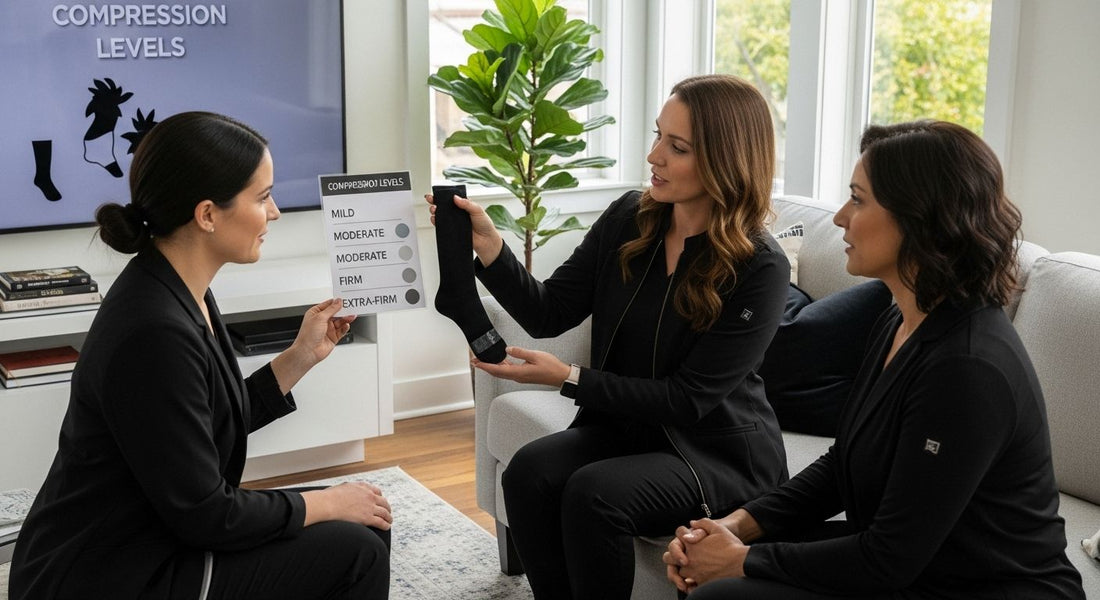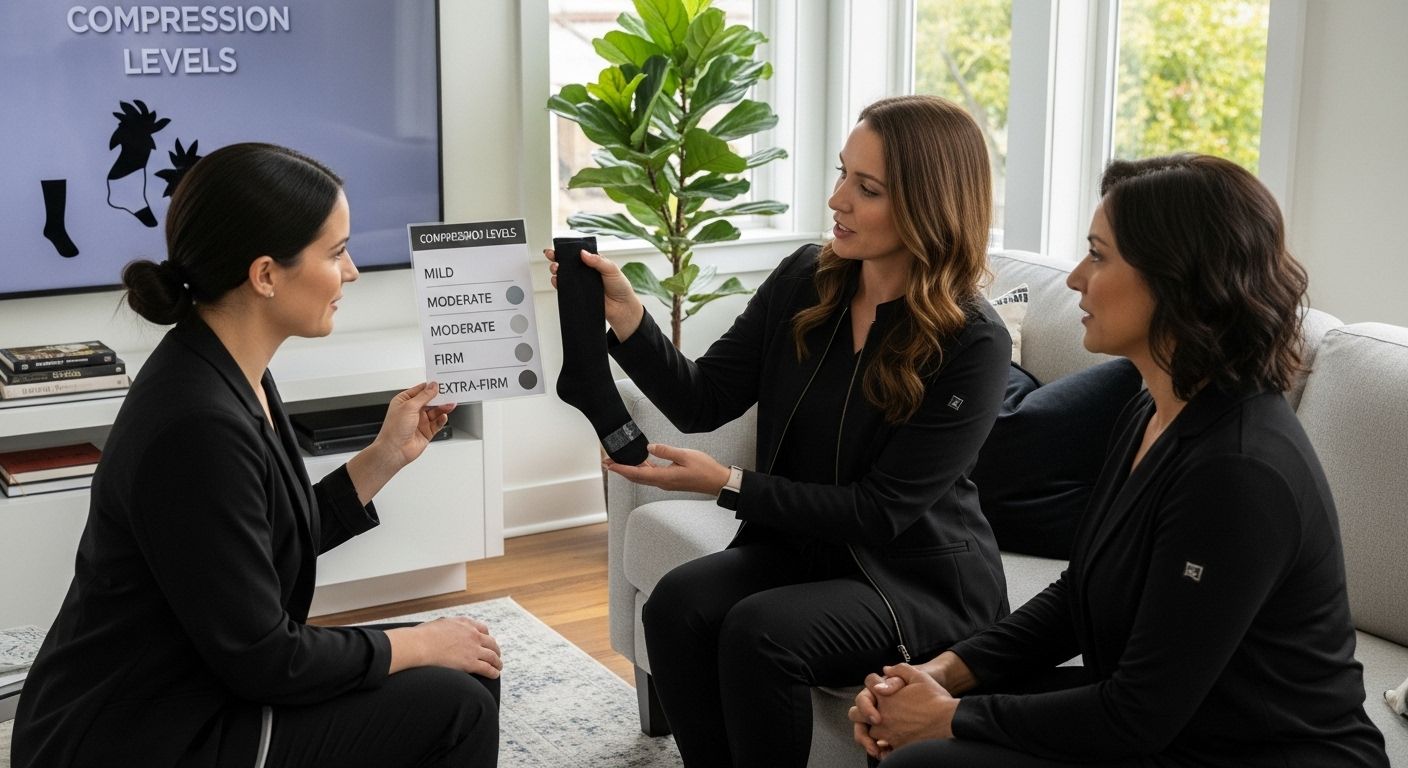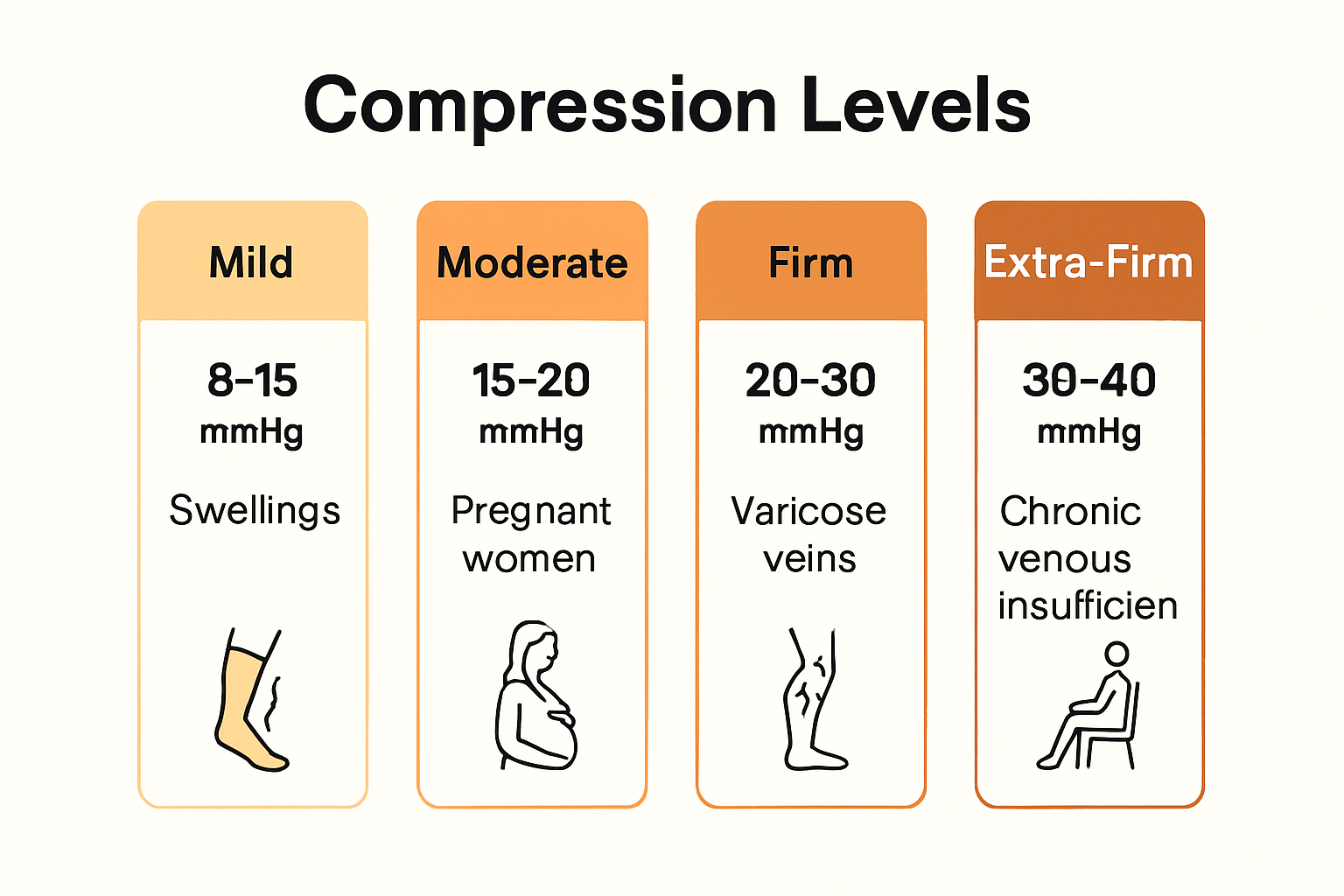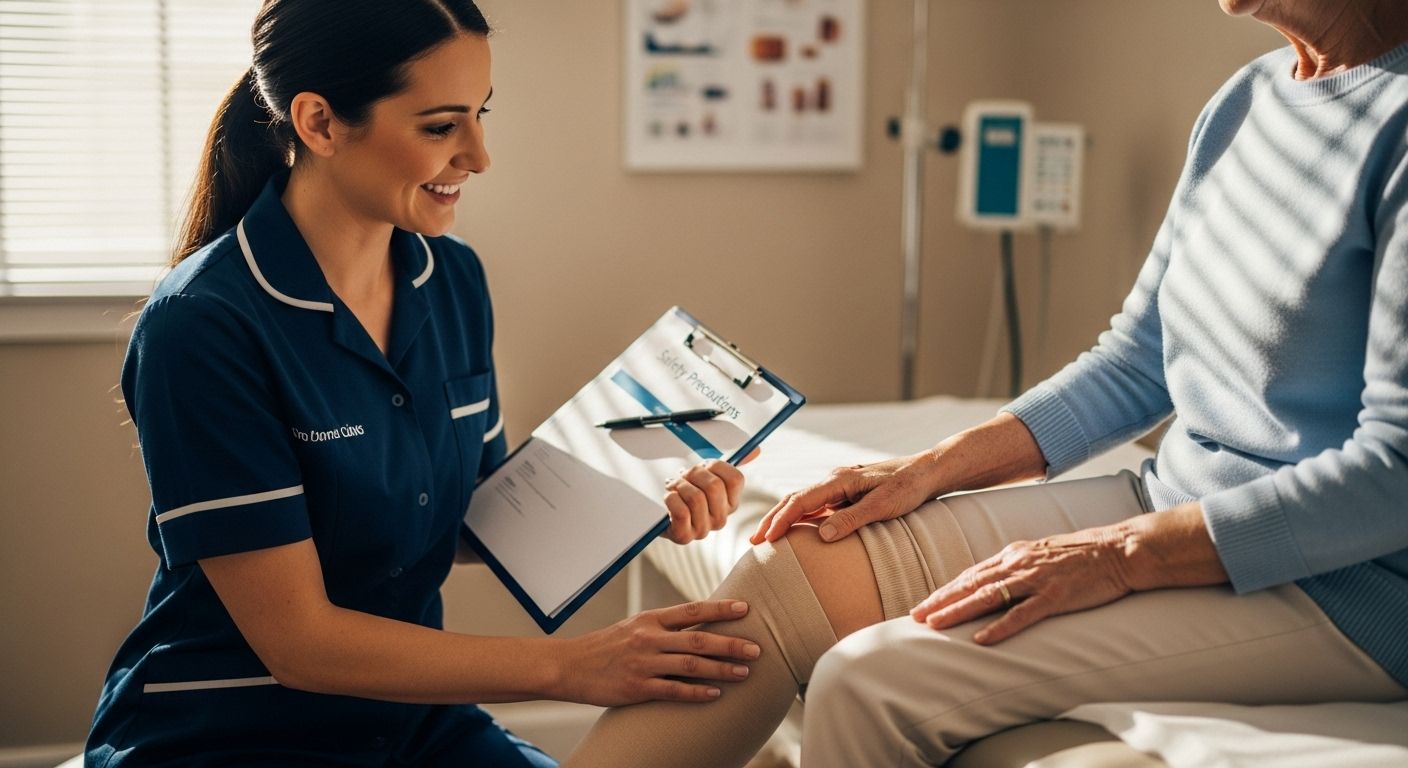
Understanding Different Compression Levels for Healthy Legs 2025
Share

Most people think compression socks are just for athletes or travelers, but the science behind these garments goes much deeper. Believe it or not, the right pair can apply anywhere from 8 to 40 mmHg of pressure, enough to make a noticeable impact on circulation and swelling. Still, what surprises most is that choosing the wrong compression level can do more harm than good, making the difference between comfort and complications much greater than you might expect.
Table of Contents
- What Different Compression Levels Mean
- How to Choose the Right Compression Level
- Who Benefits Most from Different Compression Levels
- Tips for Safe and Effective Compression Use
Quick Summary
| Takeaway | Explanation |
|---|---|
| Choose compression based on mmHg levels. | Different levels, measured in mmHg, target specific health needs and conditions effectively. |
| Consult healthcare professionals for guidance. | Medical experts assess individual requirements to recommend the most suitable compression level for leg health. |
| Consider personal comfort and lifestyle. | Your daily activities and comfort levels are crucial for selecting the most appropriate compression garments. |
| Practice proper application techniques. | Correctly applying compression garments maximizes benefits and reduces the risk of complications like skin irritation. |
| Monitor skin health and garment condition. | Regularly check for irritation and maintain the garments to ensure effective support and comfort. |
What Different Compression Levels Mean

Compression therapy relies on precise pressure measurements to provide targeted support for leg health. Understanding different compression levels is crucial for selecting the right therapeutic garment that addresses specific medical needs and circulatory conditions.
Decoding Compression Pressure Measurements
Compression levels are scientifically measured in millimeters of mercury (mmHg), which indicates the amount of pressure applied at specific points on the leg. Medical research from the National Institutes of Health categorizes compression into distinct classes based on pressure intensity, allowing healthcare professionals and patients to match garments with specific health requirements.
Compression Level Categories:
- Mild Compression (8-15 mmHg): Ideal for everyday wear, preventing minor swelling and supporting general leg comfort
- Moderate Compression (15-20 mmHg): Recommended for mild varicose veins, preventing blood pooling during pregnancy or extended sitting
- Firm Compression (20-30 mmHg): Typically prescribed for more significant circulatory issues like chronic venous insufficiency
- Extra Firm Compression (30-40 mmHg): Used for serious medical conditions such as lymphedema or post-surgical recovery
Here is a summary table comparing the main compression level categories, their pressure ranges, and common uses to help you quickly identify which might suit your needs:
| Compression Level | Pressure Range (mmHg) | Typical Uses |
|---|---|---|
| Mild | 8-15 | Everyday wear, minor swelling, general leg comfort |
| Moderate | 15-20 | Mild varicose veins, pregnancy, long sitting/standing |
| Firm | 20-30 | Chronic venous insufficiency, post-surgery, edema |
| Extra Firm | 30-40 | Lymphedema, post-surgical recovery, severe disorders |
Medical Applications of Compression Levels
Each compression level serves a unique physiological purpose. According to thrombosis research, different pressure gradients help manage various health conditions by promoting blood circulation, reducing inflammation, and preventing fluid accumulation.
Mild compression levels (8-15 mmHg) work best for individuals with minimal leg discomfort or those seeking preventative support. These levels provide gentle pressure that encourages blood flow without feeling restrictive. They are perfect for travelers, office workers, and individuals who spend extended periods sitting or standing.
Moderate compression levels (15-20 mmHg) become essential for people experiencing early signs of venous insufficiency. These levels help manage mild swelling, reduce the risk of blood clots, and provide relief for individuals with early-stage varicose veins. Pregnant women and individuals recovering from minor surgical procedures often benefit from this compression range.
Firm and extra firm compression levels (20-40 mmHg) are primarily medical-grade solutions. Healthcare providers prescribe these for more complex circulatory challenges. Patients with deep vein thrombosis, severe varicose veins, or lymphatic disorders require these higher pressure ranges to effectively manage their conditions.
Choosing the Right Compression Level
Selecting an appropriate compression level is not a one-size-fits-all decision. Factors like individual health history, current medical conditions, and professional medical advice play critical roles. Research published in medical journals emphasizes the importance of consulting healthcare professionals to determine the most suitable compression level.
Before selecting compression stockings, consider consulting with a healthcare provider who can assess your specific needs. They can recommend the most appropriate compression level based on your medical history, current health status, and potential risk factors.
Read our comprehensive guide on choosing the right compression socks to make an informed decision tailored to your unique health requirements.
How to Choose the Right Compression Level
Selecting the appropriate compression level requires careful consideration of individual health needs, lifestyle factors, and professional medical guidance. Understanding how to match compression levels with specific health conditions can significantly improve therapeutic outcomes and personal comfort.
Assessing Individual Health Requirements
Research from the National Center for Biotechnology Information highlights that compression levels are not universal but must be tailored to specific medical conditions. Different health scenarios demand unique pressure gradients to effectively manage circulatory challenges.
Key Health Factors to Consider:
- Current medical diagnoses
- Severity of circulatory issues
- Presence of swelling or inflammation
- History of venous disorders
- Recommendations from healthcare professionals
Patients with mild symptoms might require lower compression levels (8-15 mmHg), while those experiencing more complex circulatory challenges could need firmer pressure ranges (20-40 mmHg). According to Tallahassee Memorial Health, consulting a healthcare provider is crucial for determining the most appropriate compression level.
Professional Medical Guidance
Healthcare professionals play a critical role in recommending compression levels. Vascular specialists, phlebologists, and primary care physicians can conduct comprehensive assessments to identify the most suitable compression therapy.
During a medical consultation, expect a thorough evaluation that may include:
- Detailed medical history review
- Physical examination of leg circulation
- Diagnostic tests like ultrasound or venous doppler
- Assessment of current symptoms and risk factors
NY Metro Vein’s clinical guidelines suggest specific compression levels for different conditions:
- 8-15 mmHg: Minor leg discomfort and preventive care
- 15-20 mmHg: Moderate swelling and early varicose veins
- 20-30 mmHg: Significant swelling and advanced varicose veins
- 30-40 mmHg: Severe venous insufficiency and lymphedema
Lifestyle and Personal Comfort Considerations
Beyond medical recommendations, personal comfort and lifestyle play significant roles in choosing compression levels. Factors like daily activity, occupation, and personal tolerance for pressure can influence the most suitable compression garment.
Athletes and active individuals might prefer moderate compression levels that support muscle recovery and reduce fatigue. Office workers spending long hours seated could benefit from mild to moderate compression to prevent blood pooling and reduce swelling.
Pay attention to how compression stockings feel. They should provide support without causing discomfort or cutting off circulation. If a garment feels too tight or restrictive, consult a healthcare professional to adjust the compression level.
Check out our comprehensive guide to finding your perfect compression fit for more detailed insights into selecting the right compression level for your specific needs.
Who Benefits Most from Different Compression Levels
Compression therapy offers targeted support for various health conditions and lifestyle needs. Understanding which specific groups benefit most from different compression levels can help individuals make informed decisions about their leg health and circulatory support.
Medical Conditions and Compression Therapy
Research published in medical journals reveals that specific medical conditions require tailored compression levels for optimal therapeutic outcomes. Different pressure gradients address unique physiological challenges across various health scenarios.
Primary Medical Groups Benefiting from Compression:
- Patients with venous insufficiency
- Individuals recovering from surgery
- People with lymphatic disorders
- Patients managing diabetes-related circulation issues
- Individuals with chronic leg swelling
Patients with mild venous insufficiency typically benefit from lower compression levels (8-15 mmHg), which provide gentle support and encourage blood circulation. More severe conditions like chronic venous disorders or post-surgical recovery might require moderate to firm compression ranges (20-40 mmHg).
Lifestyle and Occupational Benefits
According to research from medical journals, compression levels can significantly impact different professional and lifestyle groups:
Professionals Benefiting from Specific Compression Levels:
- Healthcare Workers (12-20 mmHg): Prolonged standing requires consistent leg support
- Athletes and Fitness Enthusiasts (15-20 mmHg): Muscle recovery and reduced fatigue
- Office Workers (15-20 mmHg): Preventing blood pooling during extended sitting
- Travelers (15-20 mmHg): Reducing risk of deep vein thrombosis during long flights
Here is a table summarizing which population groups commonly benefit from specific compression levels and their primary needs:
| Group | Recommended Compression (mmHg) | Primary Benefit/Need |
|---|---|---|
| Healthcare Workers | 12-20 | Support for prolonged standing |
| Athletes/Fitness Enthusiasts | 15-20 | Muscle recovery, reduced fatigue |
| Office Workers | 15-20 | Prevent blood pooling, reduce swelling |
| Travelers | 15-20 | DVT prevention on long flights |
| Post-Surgical Patients | 20-30 | Swelling reduction, healing support |
| Seniors | 8-15 | Gentle support, comfort with reduced mobility |
| Pregnant Women | 15-20 | Swelling prevention, varicose vein support |
Airline crew, frequent travelers, and individuals with sedentary jobs particularly benefit from mild to moderate compression levels. These pressure ranges help prevent blood stasis, reduce leg fatigue, and minimize the risk of developing circulatory complications.
Special Population Considerations
Certain population groups require specialized compression strategies. Pregnant women, for instance, often experience significant leg swelling and benefit from specific compression levels that provide comfort and support without excessive pressure.
Specialized Compression Recommendations:
- Pregnant Women (15-20 mmHg): Managing leg swelling and preventing varicose veins
- Seniors (8-15 mmHg): Gentle support for reduced mobility
- Athletes (20-30 mmHg): Enhanced muscle recovery and performance
- Post-Surgical Patients (20-30 mmHg): Preventing blood clots and supporting healing
People with diabetes must exercise extra caution. Compression levels should be carefully selected to avoid restricting already compromised circulation. Consulting healthcare professionals becomes crucial in these scenarios.
Individuals with specific health concerns should always consult medical professionals to determine the most appropriate compression level. Explore our comprehensive guide for personalized compression recommendations to find the perfect support for your unique needs.
Tips for Safe and Effective Compression Use
Compression therapy offers significant health benefits, but proper usage is crucial to maximize effectiveness and prevent potential complications. Understanding the correct approach to wearing and maintaining compression garments ensures optimal support and comfort.
Proper Application and Wearing Techniques
Research from the National Institutes of Health highlights the importance of correct compression stocking application. Improper use can diminish therapeutic benefits and potentially cause skin irritation or circulation issues.
Key Application Guidelines:
- Ensure hands are clean and dry before handling stockings
- Apply stockings first thing in the morning when leg swelling is minimal
- Smooth out wrinkles to prevent uneven pressure distribution
- Avoid pulling or stretching the fabric excessively
- Check for proper alignment and smooth fit against the skin
Below is a process table summarizing the main steps for safe and effective application of compression stockings:
| Step | Action |
|---|---|
| 1 | Clean and dry hands before handling stockings |
| 2 | Apply stockings in the morning before swelling develops |
| 3 | Smooth out fabric to eliminate wrinkles |
| 4 | Avoid excessive stretching or pulling |
| 5 | Check for proper fit and alignment against the skin |
Put on compression stockings while sitting or lying down to minimize muscle tension. Use gloves or donning aids if you have difficulty stretching the fabric. Carefully roll the stocking up your leg, ensuring even distribution without creating tight spots that could restrict circulation.
Skin and Garment Maintenance
Regular inspection and proper care are essential for safe compression therapy. Skin health and garment condition directly impact the effectiveness and comfort of compression support.
Daily Care Recommendations:
- Inspect skin daily for signs of irritation, redness, or pressure marks
- Wash stockings after each use using mild detergent
- Allow stockings to air dry completely
- Replace stockings every 3-6 months or as recommended by manufacturer
- Monitor skin for any changes or persistent discomfort
People with sensitive skin or underlying health conditions should be particularly vigilant. If you notice persistent skin changes, consult a healthcare professional. Learn more about proper compression stocking maintenance to extend the life of your garments and protect your skin.
Safety Precautions and Potential Limitations

While compression therapy offers numerous benefits, it is not universally suitable for everyone. Understanding potential limitations and consulting healthcare professionals ensures safe and effective use.
Important Safety Considerations:
- Avoid compression if you have severe peripheral arterial disease
- Consult a doctor if you have open wounds or skin infections
- Be cautious with diabetes or reduced skin sensitivity
- Watch for signs of reduced circulation like increased pain or color changes
- Remove stockings immediately if experiencing unusual discomfort
Patients with complex medical histories should undergo a comprehensive assessment before starting compression therapy. Individuals with conditions like severe heart failure, untreated deep vein thrombosis, or significant arterial insufficiency might require specialized medical guidance.
Always start with lower compression levels and gradually increase as tolerated. Pay attention to your body’s response and be prepared to adjust your approach. If you experience persistent discomfort or unusual symptoms, discontinue use and consult a healthcare professional.
Compression therapy is a powerful tool for managing leg health, but it requires informed and careful application. By following these guidelines, you can safely harness the therapeutic benefits of compression stockings while protecting your overall well-being.
Frequently Asked Questions
What are the different compression levels for compression socks?
Compression levels range from 8 to 40 mmHg. Mild compression (8-15 mmHg) is for everyday comfort, moderate (15-20 mmHg) is for mild varicose veins, firm (20-30 mmHg) is for significant circulatory issues, and extra firm (30-40 mmHg) is for serious medical conditions.
How do I choose the right compression level for my needs?
Consult with a healthcare professional to assess your individual health requirements. Factors to consider include current medical conditions, lifestyle, and personal comfort. Different levels target specific circulatory issues effectively.
Who benefits the most from using compression socks?
Individuals with medical conditions like venous insufficiency, those recovering from surgery, pregnant women, athletes, and office workers can all benefit from different compression levels. Each group has unique needs that specific compression levels can address.
What should I do if I experience discomfort while wearing compression stockings?
If you experience discomfort or signs of reduced circulation, remove the stockings and consult a healthcare professional. It’s important to ensure the selected compression level is appropriate and to monitor skin health regularly.
Discover the Right Compression for Your Healthier Legs
Are you worried about making the wrong choice when it comes to compression levels for leg health? The article highlights a real struggle: choosing between mild and firm compression, reading mmHg ratings, and making sure your support matches your specific medical needs. If you face swelling, varicose veins, pregnancy-related discomfort, or want to prevent leg fatigue, the right compression stockings make all the difference. Fit Stockings provides access to trusted brands like Jobst and a complete range of medically approved gradients, including expertly chosen 15-20 mmHg options tailored for daily support and moderate symptoms.
Do not let confusion slow you down. Shop confidently at Fit Stockings for professionally curated solutions, with free shipping and practical guides to help you measure and select your perfect fit. Take charge of your comfort and circulation today before your symptoms can hold you back.
Recommended
-
Compression Stockings Fitting Guide 2025: Find the Perfect Fit – Fit Stockings
-
Compression Stockings for Elderly: 2025 Guide to Healthier Legs – Fit Stockings
-
Compression Stockings and Diabetes: What to Know in 2025 – Fit Stockings
-
How to Choose Compression Socks: A Helpful Guide for 2025 – Fit Stockings
-
[ How to Pair Leggings with Tops for a Chic and Comfortable Look
– Be Juliet](https://bejuliet.com/blogs/blog/how-to-pair-leggings-with-tops-for-a-chic-and-comfortable-look)
-
Why Your Body Feels Heavy: Surprising Reasons and Ways to Fix It - Dietium

